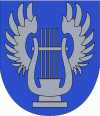Järvenpää
 |
The first documented mention of the village of Järvenpää is found in a tax list from 1540, where it is named in Swedish as Treskendaby; starting from the next decade, its Finnish name was used in parallel, in forms such as Jerffuepä or Järuenpää. Around this time, the village was documented to consist of eight estates. Prior to being transferred to the newly formed chapel of Tuusula in 1643, Järvenpää was part of the parish of Sipoo; Tuusula, in turn, became an independent pastorate (kirkkoherrakunta) in 1654.
While the population in Järvenpää had long been stagnant, it had started expanding again by the late 1700s, thanks to the evolution of agriculture at the time. In the middle of the 1800s, Järvenpää together with Nummenkylä formed the most populous village of Tuusula with around 450 inhabitants. Thanks to its location on the road between Helsinki and Mäntsälä, the village had grown into a minor concentration of commerce, with the presence of a kestikievari - a type of tavern - and several craftsmen. Thanks to these factors, one of the original intermediate stations of the Helsinki–Riihimäki railway was placed in Järvenpää.
Järvenpää was separated from its parent community Tuusula in 1951. Järvenpää was granted the status of a market town (kauppala) after the separation. Neighbouring districts Kellokoski and Nummenkylä were not added to the municipality of Järvenpää and the controversy over the issue still raises blood pressure fifty years later. In the event, Kellokoski remained part of the municipality of Tuusula. Bjarne Westermarck developed Järvenpää and is considered to be the founder of the town and was honored at its centennial celebrations by the release of a book about Järvenpää. Järvenpää was granted full legal town (kaupunki) status in 1967.
Map - Järvenpää
Map
Country - Finland
 |
 |
| Flag of Finland | |
Finland was first inhabited around 9000 BC after the Last Glacial Period. The Stone Age introduced several different ceramic styles and cultures. The Bronze Age and Iron Age were characterized by contacts with other cultures in Fennoscandia and the Baltic region. From the late 13th century, Finland became a part of Sweden as a consequence of the Northern Crusades. In 1809, as a result of the Finnish War, Finland became part of the Russian Empire as the autonomous Grand Duchy of Finland, during which Finnish art flourished and the idea of independence began to take hold. In 1906, Finland became the first European state to grant universal suffrage, and the first in the world to give all adult citizens the right to run for public office. After the 1917 Russian Revolution, Finland declared independence from Russia. In 1918, the fledgling state was divided by the Finnish Civil War. During World War II, Finland fought the Soviet Union in the Winter War and the Continuation War, and Nazi Germany in the Lapland War. It subsequently lost parts of its territory, but maintained its independence.
Currency / Language
| ISO | Currency | Symbol | Significant figures |
|---|---|---|---|
| EUR | Euro | € | 2 |
| ISO | Language |
|---|---|
| FI | Finnish language |
| SV | Swedish language |
















